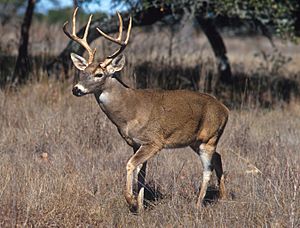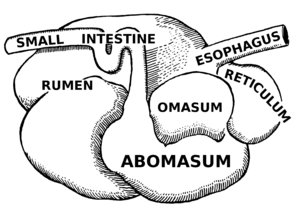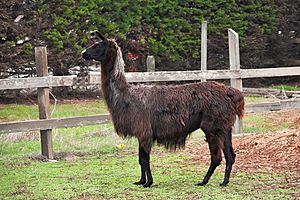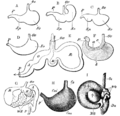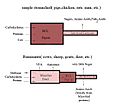Ruminant facts for kids
A ruminant is a type of mammal that eats and digests plant-based foods like grass. These animals have a special way of digesting their food. The word "ruminant" comes from a Latin word, ruminare, which means "to chew over again".
Some common ruminants you might know include cattle (cows), goats, sheep, giraffes, bison, yaks, water buffalo, deer, camels, alpacas, llamas, wildebeest, antelope, pronghorn, and nilgai.
Ruminants first chew and swallow their food like other animals. But then, they bring up the half-digested food, called cud, back to their mouth. They chew this cud again to get as much goodness out of it as possible. This process helps them break down tough plant material into tiny pieces.
Contents
How Ruminants Digest Food
The main difference between a ruminant and animals like humans, dogs, or pigs is that ruminants have a special stomach with four parts. These four parts are called the rumen, reticulum, omasum, and abomasum.
The First Two Chambers
When a ruminant eats, the food first goes into the rumen and reticulum. These two parts work together as one big space. Here, the food mixes with saliva and separates into solid and liquid layers. The solid parts clump together to form the cud.
Tiny living things like bacteria and fungi live in the rumen and reticulum. They help break down tough plant fibers, especially something called cellulose.
Chewing the Cud
After the food has been in the rumen and reticulum for a while, the cud is brought back up to the mouth. The animal then chews it slowly. This extra chewing makes the food particles even smaller.
The Last Two Chambers
Once the cud is chewed again and swallowed, it moves to the next part of the stomach, the omasum. In the omasum, the animal's body takes in water and many important minerals from the food.
After the omasum, the food goes into the abomasum. This part is like the "true stomach" because it works much like a human stomach. Real digestion, where the food is broken down even more, happens here.
Finally, the digested food moves into the small intestine, where the body absorbs most of the nutrients. Water is absorbed in the large intestine, and then the waste leaves the body.
Because the tiny living things in the rumen use up most of the sugar (glucose) from the food, ruminants don't absorb much glucose from their small intestine. Instead, their body, especially the liver, makes the glucose they need for things like brain function.
Where Ruminants Live
There are about 3.5 billion domestic ruminants around the world. Most of these are cattle, goats, and sheep.
There are also about 75 million wild ruminants living in different habitats across the globe.
Images for kids
See also
 In Spanish: Ruminantia para niños
In Spanish: Ruminantia para niños


